2017 In Review
2017 was a memorable year for many reasons, not the least of which was celebrating Canada’s sesquicentennial. Events that were local and national in scope and feel brought new conferences, tourists, and visitors to celebrate 150 years in many wondrous ways. As the gateway into Canada’s Capital Region, the Ottawa International Airport played a central role in the celebrations as the first point of welcome for all air travellers. From Red Bull Crashed Ice to the Juno Awards, the official 150th Birthday Party on Parliament Hill on July 1st to La Machine and Kontinuum, from the Grey Cup to the NHL’s Outdoor Classic, and everything in-between, we were proud to partner with the City of Ottawa, Ottawa 2017, the Ottawa Sports and Entertainment Group, the Ottawa Senators and many organizations and individuals who made Ottawa the place to be in 2017.
The Authority also marked a significant milestone in its history, with its 20th anniversary. On February 1st, 1997, Transport Canada turned over the care and control of the Airport to the newly-formed Board of Directors and Senior Management team to form the Ottawa Macdonald-Cartier International Airport Authority (OMCIAA). That day marked the start of major changes in the Airport, including U.S. pre-clearance, a new Combined Services Building, a new Passenger Terminal Building, and so many more accomplishments that have made the community proud. As always, the successes are due to the commitment of every Authority employee, the guidance of engaged and enthusiastic Board members, and the support and encouragement of the Ottawa-Gatineau community, for which we say thank you.
Amid the celebratory atmosphere, we also accomplished a great deal in 2017 and advanced many of the projects outlined in the Authority’s Strategic Plan. The Plan, which is developed with the Authority’s Board of Directors, covers a five-year timeline and includes projects that fall under five Strategic Directions that will be discussed in this report.
To grow strategically
The Authority continues to focus on business activities that will expand our non-aeronautical revenue base, with the goal of keeping the cost of flying as low as possible for our customers.
Airport Privatization Coalition
In 2016, we discussed the Canadian Transportation Agency (CTA) Review (Emerson Report) that The Honourable Marc Garneau, Minister of Transport, tabled in the House of Commons. While we were in agreement with most of the recommendations, there was one that we could not accept – moving from a private, not-for-profit governance model to a private, for-profit model. Our analysis showed that rates in an already burdened user-pay system would likely have to increase in order to achieve a return on investment for potential buyers. To strengthen the message to elected officials, stakeholders, and the general public, the Ottawa, Vancouver and Calgary airport authorities joined forces to tackle the issue. Local efforts to enlist supporters were successful with chambers of commerce, trade unions, several city councils and other key stakeholders putting their support of the current airport governance model in writing to the federal government. Other activities during the year included the launch of www.noairportselloff.ca to raise awareness of the issue, and the development of a feedback tool to allow website visitors to communicate their opposition to their elected officials. While overall government activity on the file diminished towards the end of 2017, we will continue to monitor and take further action as necessary.
New Business Ventures in Customer Transportation Parking Services (CTPS)
Car parking revenues increased to $15.2 million from $14.3 million in 2016, an increase of $0.9 million or 6.7%, thanks to steady passenger growth attributed to the many events across the region marking Canada’s 150th, and revived business/government travel. Ground Transportation also experienced solid growth. The municipal introduction of Private Transportation Companies (PTCs) provided the Authority the opportunity to negotiate fair market fees with inaugural provider, Uber, contributing to financial stability going forward. Non-aeronautical revenues are vital to the Authority’s ability to maintain airport infrastructure, such as the commercial and public roadways outside the terminal, in a safe and secure manner.

Benjamin Mathieu, General Manager, Airports, and Mark Laroche cut the ribbon to officially introduce Astral Out Of Home’s digital advertising program in Arrivals on August 22nd.
Astral Digital Advertising
In 2014, the Airport Authority tendered its in-terminal advertising program with the goal of modernizing and streamlining the advertising assets. Astral Out of Home’s winning solution promised a modern, flexible signature style, that would use a minimal footprint while delivering maximum impact. The Astral activation features significant deployment of digital spectacular boards, interactive touch-screens, baggage carousel towers, and the Samsung “iconic” wall in Arrivals. Completion of the multi-year deployment was celebrated on August 22nd at the official launch ceremony in the Arrivals area.
SUMMARY OF AMOUNTS SPENT IN THE OTTAWA REGION
| (IN MILLIONS OF CANADIAN DOLLARS) | 2013 $ |
2014 $ |
2015 $ |
2016 $ |
2017 $ |
TOTAL $ |
|---|---|---|---|---|---|---|
| Wage bill | 20.1 | 20.9 | 21.5 | 22.7 | 23.8 | 108.3 |
| Payments in lieu of municipal taxes | 5.0 | 4.9 | 5.0 | 5.0 | 5.1 | 25.0 |
| Operations costs | 27.0 | 29.0 | 31.0 | 33.0 | 33.8 | 153.4 |
| Capital costs | 30.0 | 54.0 | 31.2 | 24.0 | 35.0 | 174.2 |
| 82.1 | 108.8 | 88.7 | 84.7 | 97.7 | 460.9 |
Notes:
Wage bill includes benefits;
Payments in lieu of municipal taxes (PILT) – paid to the City of Ottawa;
Operations costs do not include rent, PILT, payroll, depreciation and interest expenses.
To increase the economic footprint of the airport within Canada’s Capital Region
The Authority understands the role it plays in the community as an economic engine and major employer. That role includes enriching the community by supporting events and other initiatives that contribute to the financial and social well-being of Ottawa-Gatineau.
Concession Preliminary Design Document
The Authority is in the process of redefining its overall concessions program. Following an internal review of the concession offering, and in consultation with major industry operators in the food/beverage/retail sectors, the Authority issued an RFP in the fall with the goal of selecting an architectural firm to carry out a technical and design study for the new program, which is expected to launch in 2020.
Economic Impact Study
The Authority engaged consulting firm WSP Canada to update its Economic Impact Study. The Study, which was last completed in 2011, measures the Airport’s contribution to the local economy. Measurements include employment, wages, gross domestic product, among others, and are based on direct, indirect and induced impacts. The Study confirms that the Ottawa International Airport continues to be a major contributor to the prosperity of the local economy, generating $2.2 billion in total output each year. With passenger volumes tracking at approximately 2.0% for the past couple of years, and with similarly steady growth projected going forward, the Study anticipates that the Airport’s economic output will track to approximately $2.5 billion by 2021.
| Economic Impact Study | |
|---|---|
| Impact on GDP | $1.04 billion |
| Employment Generated | 10,776 |
| Wages and salaries generated | $602.3 million |
| Total income tax generated | $109.9 million |
| Average full time equivalent annual salary | 10% higher than the provincial norm |
| Total annual output | $2.2 billion |
Light Rail Transit
The Authority continues to work closely with the City of Ottawa towards an airport link as part of Stage 2 of the Light Rail Transit (LRT) project. We were very pleased with the federal government’s confirmation of its funding support for Stage 2 LRT, including the airport link, adding to the provincial government’s commitment in 2016.
The Authority reached an agreement in principle with the City concerning the delineation of work at the airport station. The City will construct the rail line and station platform through their contract, while the Authority will build a station and concourse on an independent structure that will provide passengers with a climate-controlled area to wait for the train as well as a connecting structure to the terminal. Efforts early in 2018 will be focused on formalizing the agreement as well as dealing with infrastructure issues associated with construction of the line, including the coordination and relocation of municipal services.
Marketing a Key Destination – NYCx3
Through the summer months, the Authority launched a marketing campaign aimed at promoting the three air service options to New York City. NYCx3 was edgy, unique, and focused on the heart and soul of the NYC experience using visuals that were taken by a New York City photographer specifically for this campaign. There were three grand prizes of roundtrip airfare to New York City provided by the three airlines that serve NYC. Overall, the program was a success with 1,759 contest entries, 4,120 clicks on the ads and 2,234,746 impressions generated.

Photographer Samantha Light captured the heart and soul of the New York City experience for the NYCx3 campaign.
Master Plan
The 2018 Master Plan process, which was launched in late 2016, continued more earnestly in 2017. Activities included a comprehensive review of the existing Airport Master Plan and Land Use Plan to ensure continued operational and service excellence in the management of the Airport through the next 20 years. Stakeholder outreach and surveys facilitated updates to aviation forecasts, identified support facility and service requirements, quantified utilities capacity and requirements as well as potential development options to meet forecasted needs.
Two rounds of public meetings were held in Ottawa and Gatineau in the second half of 2017. The final round, held in January 2018, included a presentation of the draft plan, which was submitted to the Board of Directors, followed by Transport Canada in early March.
Terminal Hotel Request for Proposal
A request for proposal for the construction and operation of a hotel at the Airport closed on October 27th. Multiple submissions, proposing to integrate the new hotel structure into the terminal via the Parkade, have been evaluated and discussions have commenced.

Tim Hortons opened a new café on level 2 in the Transborder holdroom.
Transborder Enhancements
A project to relocate the Duty-Free shop from Level 3 to Level 2 in the Transborder holdroom was completed in June, which made space available for an expanded Tim Hortons café with a seating area on Level 3. The new café was completed and opened in time for the start of the holiday travel season in December.
YOW Showcase
The Authority established a space in Arrivals to feature some of the unique aspects of our region that make Ottawa-Gatineau a great place to live, work and play. Named the YOW Showcase, the program welcomed the Ottawa 2017 Bureau as its first participant. Their interactive kiosk installation offered our visitors a glimpse into what the region had to offer during the sesquicentennial celebration year in Ottawa-Gatineau. Visitors were able to find information about the region, 2017 events and volunteer opportunities throughout the year. Ross Video finished the year with an impressive display that featured the Technical Emmy Award presented to the company in 2016 for its contribution to the international video production industry. The award confirmed Ross Video as a global leader in its highly specialized field. New participants will be welcomed in 2018 and beyond.
Giving Back
Project Clear Skies
Mark Laroche presented the first cheque of the 2017 Project Clear Skies funding wave at the Centre Artisanal pour la Déficience-intellectuelle de l’Outaouais, where funds will be used to purchase tables and chairs for the centre. Now in its 13th year, Project Clear Skies has injected more than $1.6 million into local charitable projects that are making a meaningful difference in the quality of life for many in Ottawa-Gatineau. To learn more about how just over $100,000 was invested in local projects in 2017, visit https://yow.ca/en/yow-and-community/project-clear-skies.
In addition to Project Clear Skies, the Authority also supported a number of other community initiatives.
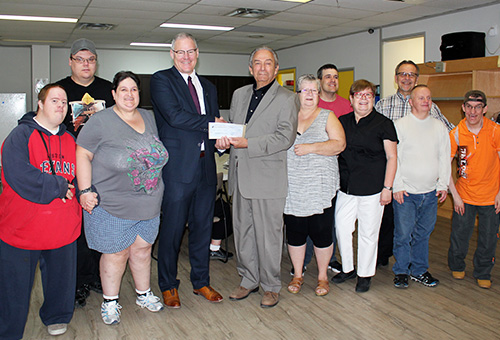
Mark Laroche presented the first check of the 2017 funding wave to the Centre Artisanal pour la Déficience-intellectuelle de l’Outaouais.
Local Flood Relief
From donating to local fundraising efforts to providing 4,000 bottles of water and our employees pitching in to help clear debris from flood sites, the Authority provided assistance in both Ottawa and Gatineau.
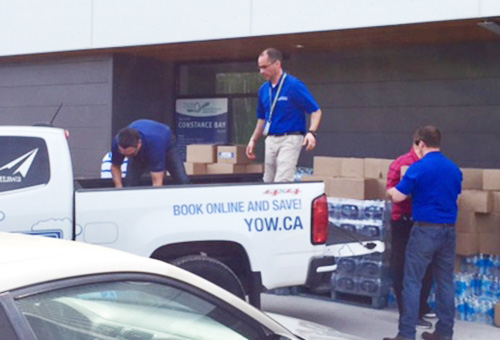
Airport Authority employees load bottles of water for delivery to local flood sites.
WestJet’s Day 7 of 12 Flights of Christmas
As a part of its annual holiday campaign, 12 Flights of Christmas, Westjet transformed Gate 13 into a gingerbread house, complete with a candy bar and other sweets. Day 7 in Ottawa also included a visit from Mrs. Claus who distributed gifts to all passengers, including gift cards and the coveted Gift of Flight for a few fortunate Calgary-bound WestJet passengers. It was the Authority’s pleasure to work with WestJet to make this special day a reality.
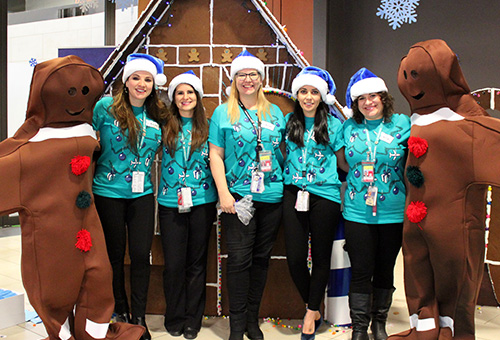
Ottawa Airport welcomed Day 7 of Westjet’s 12 Flights of Christmas on
November 24th.
PASSENGER GROWTH BY SECTOR
| DOMESTIC | % | TRANSBORDER | % | INTERNATIONAL | % | TOTAL | % | ||
|---|---|---|---|---|---|---|---|---|---|
| Actual | 1996 | 2,223,941 | 529,602 | 104,295 | 2,857,838 | ||||
| 1997 | 2,435,534 | 9.5% | 502,072 | -5.2% | 108,762 | 4.3% | 3,046,368 | 6.6% | |
| 1998 | 2,414,355 | -0.9% | 563,085 | 12.2% | 133,108 | 22.4% | 3,110,548 | 2.1% | |
| 1999 | 2,426,288 | 0.5% | 628,203 | 11.6% | 157,116 | 18.0% | 3,211,607 | 3.3% | |
| 2000 | 2,562,282 | 5.6% | 719,200 | 14.5% | 152,863 | -2.7% | 3,434,345 | 6.9% | |
| 2001 | 2,625,630 | 2.5% | 618,694 | -14.0% | 146,971 | -3.9% | 3,391,295 | -1.3% | |
| 2002 | 2,445,770 | -6.9% | 600,365 | -3.0% | 170,751 | 16.2% | 3,216,886 | -5.1% | |
| 2003 | 2,491,691 | 1.9% | 588,088 | -2.0% | 182,566 | 6.9% | 3,262,345 | 1.4% | |
| 2004 | 2,736,779 | 9.8% | 641,157 | 9.0% | 231,949 | 27.0% | 3,609,885 | 10.7% | |
| 2005 | 2,779,895 | 1.6% | 719,150 | 12.2% | 236,388 | 1.9% | 3,735,433 | 3.5% | |
| 2006 | 2,807,377 | 1.0% | 735,753 | 2.3% | 264,626 | 12.0% | 3,807,756 | 1.9% | |
| 2007 | 3,052,813 | 8.7% | 746,435 | 1.5% | 289,280 | 9.3% | 4,088,528 | 7.4% | |
| 2008 | 3,255,540 | 6.6% | 740,369 | -0.8% | 343,315 | 18.7% | 4,339,225 | 6.1% | |
| 2009 | 3,141,812 | -3.5% | 682,822 | -7.8% | 408,196 | 18.9% | 4,232,830 | -2.5% | |
| 2010 | 3,303,170 | 5.1% | 725,781 | 6.3% | 444,943 | 9.0% | 4,473,894 | 5.7% | |
| 2011 | 3,429,310 | 3.8% | 750,486 | 3.4% | 444,830 | -0.0% | 4,624,626 | 3.4% | |
| 2012 | 3,454,387 | 0.7% | 775,040 | 3.3% | 456,529 | 2.6% | 4,685,956 | 1.3% | |
| 2013 | 3,363,685 | -2.6% | 772,678 | -0.3% | 442,228 | -3.1% | 4,578,591 | -2.3% | |
| 2014 | 3,434,209 | 2.1% | 741,285 | -4.1% | 440,954 | -0.3% | 4,616,448 | 0.8% | |
| 2015 | 3,488,629 | 1.6% | 735,755 | -0.7% | 431,976 | -2.0% | 4,656,360 | 0.9% | |
| 2016 | 3,679,232 | 5.5% | 673,434 | -8.5% | 390,425 | -9.6% | 4,743,091 | 1.9% | |
| 2017 | 3,813,672 | 3.6% | 647,574 | -3.8% | 378,431 | -3.1% | 4,839,677 | 2.0% | |
| Forecast | 2018 | 3,914,000 | 2.6% | 658,500 | 1.7% | 385,250 | 1.8% | 4,957,750 | 2.4% |
| 2019 | 3,992,700 | 2.0% | 674,400 | 2.4% | 397,400 | 3.1% | 5,064,500 | 2.1% | |
| 2020 | 4,074,100 | 2.0% | 689,600 | 2.3% | 409,650 | 3.1% | 5,173,350 | 2.1% | |
| 2021 | 4,159,400 | 2.1% | 705,500 | 2.3% | 422,700 | 3.2% | 5,287,600 | 2.2% | |
| 2022 | 4,243,500 | 2.0% | 722,700 | 2.4% | 436,500 | 3.3% | 5,402,700 | 2.2% | |
| 2025 | 4,515,600 | 2.1% | 772,300 | 2.2% | 476,700 | 3.0% | 5,764,600 | 2.2% | |
| 2030 | 5,013,000 | 2.1% | 845,600 | 1.9% | 541,200 | 2.6% | 6,399,800 | 2.1% |
KEY MEASUREMENTS
| PASSENGERS | ANNUAL GROWTH | AIRCRAFT MOVEMENTS | ANNUAL GROWTH | RENT TO TRANSPORT CANADA $ | ANNUAL GROWTH | ||
|---|---|---|---|---|---|---|---|
| Actual | 1997 | 3,046,368 | 6.6% | 67,867 | 3,977,000 | ||
| 1998 | 3,110,548 | 2.1% | 77,202 | 13.8% | 5,301,000 | 33.3% | |
| 1999 | 3,211,607 | 3.2% | 81,808 | 6.0% | 5,948,000 | 12.2% | |
| 2000 | 3,434,345 | 6.9% | 78,301 | -4.2% | 6,145,000 | 2.6% | |
| 2001 | 3,391,295 | -1.3% | 72,630 | -7.2% | 8,840,000 | 43.9% | |
| 2002 | 3,216,886 | -5.1% | 68,499 | -5.7% | 11,005,000 | 24.5% | |
| 2003 | 3,262,345 | 1.4% | 69,798 | 1.9% | 11,329,000 | 2.9% | |
| 2004 | 3,609,885 | 10.7% | 69,626 | -0.2% | 11,643,000 | 2.8% | |
| 2005 | 3,735,433 | 3.5% | 66,146 | -5.0% | 12,958,000 | 11.3% | |
| 2006 | 3,807,756 | 1.9% | 65,396 | -1.1% | 12,487,000 | -3.6% | |
| 2007 | 4,088,528 | 7.4% | 72,342 | 10.6% | 11,546,000 | -7.5% | |
| 2008 | 4,339,225 | 6.1% | 79,777 | 2.0% | 10,134,120 | -12.2% | |
| 2009 | 4,232,830 | -2.5% | 81,120 | 1.7% | 7,310,208 | -27.9% | |
| 2010 | 4,473,894 | 5.7% | 86,009 | 6.0% | 6,118,244 | -16.3% | |
| 2011 | 4,624,626 | 3.4% | 90,949 | 5.7% | 7,341,116 | 20.0% | |
| 2012 | 4,685,956 | 1.3% | 90,697 | -0.3% | 7,700,000 | 4.9% | |
| 2013 | 4,578,591 | -2.3% | 83,567 | -7.9% | 7,420,000 | -3.6% | |
| 2014 | 4,616,448 | 0.8% | 78,073 | -6.6% | 8,317,000 | 12.1% | |
| 2015 | 4,656,360 | 0.9% | 75,107 | -3.8% | 8,737,000 | 5.0% | |
| 2016 | 4,743,091 | 1.9% | 74,345 | -1.0% | 8,994,000 | 2.9% | |
| 2017 | 4,839,677 | 2.0% | 74,755 | 0.6% | 9,626,000 | 7.0% | |
| Forecast | 2018 | 4,957,750 | 2.4% | 78,150 | 4.5% | 10,000,000 | 3.9% |
| 2019 | 5,064,500 | 2.1% | 78,700 | 0.8% | 10,600,000 | 6.0% | |
| 2020 | 5,173,350 | 2.1% | 79,600 | 1.0% | 11,000,000 | 3.8% | |
| 2021 | 5,287,600 | 2.2% | 80,500 | 1.1% | 11,300,000 | 2.7% | |
| 2022 | 5,402,700 | 2.2% | 81,100 | 0.8% | 11,700,000 | 3.5% |
Notes:
Federal Government Net Book Value at time of transfer: $75M
Total rent projected 1997-2022: $237.5M
Forecast passenger volumes are as provided by outside consultants.
For financial planning purposes, the Authority forecasts on a more conservative basis.
To optimize operational performance, ensuring safe and secure airport operations
Whether inside the terminal or on the airfield, the Authority had a long list of projects to complete. Projects were related to airside safety enhancements, improved passenger experience, technological advancements and sustainability.
Operations and Infrastructure
Airside Construction Projects
Two airside projects were completed in 2017 in keeping with the Authority’s ongoing commitment to airside safety.
Taxiway Reconstruction
The Taxiway Reconstruction Project, involved work on a section of Taxiway Charlie (between Runway 14/32 and the end of Runway 07), and a section of Taxiway Bravo (between Taxiway Foxtrot, including a section of Taxiway Foxtrot, to the beginning of Runway 25), as well as the entrances to the First Air and FedEx aprons.
The project included the reconstruction of the taxiways with the addition of shoulders, the installation of new taxiway edge lights within the shoulders, new storm sewers, and line painting as required.
New SSALR Lighting Improves Visibility and Safety for Runway 25
The second airside project involved replacing Runway 25’s existing approach lighting system with a Simplified Short Approach Lighting System (SSALR). The new system increased the number and types of approach lights and improved visibility of Runway 25 landing during all conditions and in particular during lower visibility conditions. The distance of the lighting array from the runway threshold (the beginning of the runway that is visible for landing) was extended from 365m to 730m.
A new SSALR lighting system installation is planned for Runway 14 in 2018. SSALR lighting systems are historically only installed on “bad weather” runways with ILS approach systems. Our 07 and 32 runway approaches have had SSALR and ILS systems for decades.
Both projects required trenching and new electrical infrastructure. Unique to the taxiways was the excavation and installation of new storm sewer piping, while the SSALR project required excavations for the installation of new concrete foundations to accommodate the approach lighting towers. Several kilometres of new wiring was installed along the runway edge, and out to the Field Electrical Centre.
Irregular Operations
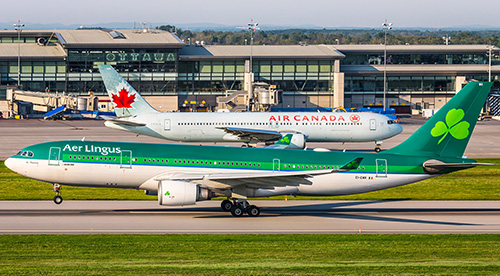
Diverted aircraft from Toronto and Montreal on July 31st
While winter weather is generally thought to have a greater impact on operations, July and August 2017 proved otherwise; with bad weather and construction impacting flow at Toronto Pearson Airport, Ottawa was on the receiving end of diverted aircraft on a regular basis. Over the year, we received 136 diverted aircraft, compared to a more typical 2016 that saw 65 in total, with July 31st presenting the most significant diversion event of the year.
Storms in both Toronto and Montreal that day resulted in 20 aircraft being diverted to Ottawa. Every available space was utilized to park aircraft that ranged in size from small regional jets to an Emirates A380, with nearly 4,000 passengers aboard from various parts of the world. These diverted aircraft were in addition to the airport’s regular operation that included 16 arrivals. Most flights were able to receive fuel and depart for their intended destination in a timely manner. Issues with several Air Transat flights, however, had them on the ground in Ottawa longer than expected, which resulted in complaints from passengers and a full inquiry by the Canadian Transportation Agency.
The Airport Authority cooperated fully with the investigation and participated in the inquiry to share the details of the coordination and assistance it facilitated the night in question. Results of the inquiry, which were made public at the end of November, directed no blame at the Authority for the issues that affected the airline’s passengers that night. The Authority was pleased that its efforts to assist were positively regarded, and is keen to work with all airport partners to facilitate better communications and planning for future Irregular Operations (IROPS).
Planning for Future Irregular Operations
As weather and other issues have an ever increasing impact on airport operations, the Authority has been working with campus partners to ensure readiness for all Irregular Operations (IROPS), including aircraft diversion events. An IROPS Contingency Response Committee has been formed with representatives from the Authority, local carriers and ground handlers, to discuss IROPS events, roles and responsibilities, and individual IROPS plans. Discussions are also ongoing with external stakeholders and airports across the country on the subject of mass diversion events and how they can be managed more effectively as a community.
Groundside Projects
Light Rail Transit
The Authority continues to work closely with the City of Ottawa towards an airport link as part of Stage 2 of the Light Rail Transit (LRT) project. We were very pleased with the federal government’s confirmation of its funding support for Stage 2 LRT, including the airport link, announced in 2017, adding to the 2016 provincial government’s commitment. Efforts early in 2018 will be focused on formalizing the agreement in principle reached with the City, as well as dealing with infrastructure issues associated with the construction of the line, the terminal station and the relocation of municipal services.

50 overhead digital signs, 22 check-in kiosks and 16 self-bag drops were deployed during the check-in hall upgrade project to better serve our passengers.
Check-in Hall Upgrade
Early in 2017, the Authority’s Information Technology team began a major overhaul of the Level 3 check-in equipment, including the baggage belt systems, check-in counters, kiosks, computers, software, scales, and signage that serve Domestic/International processing. More kiosks were added, the baggage conveyor system was replaced, and self-serve baggage drop-off stations were added for most airlines as requested. The check-in desks have been replaced with more ergonomic workspaces for airline staff. The most visible change aside from the layout of the check-in kiosks is the new overhead digital signage deployment which will allow the Authority more flexibility in the assignment of check-in space when necessary.
The project was rolled out in seven phases to minimize the impact to regular operations and was wrapped up in 2017. The project was deemed a great success thanks to the commitment and cooperation of the airlines. The Transborder check-in area will be tackled in 2018.
YOW Welcomes Canada’s First Primary Inspection Kiosks
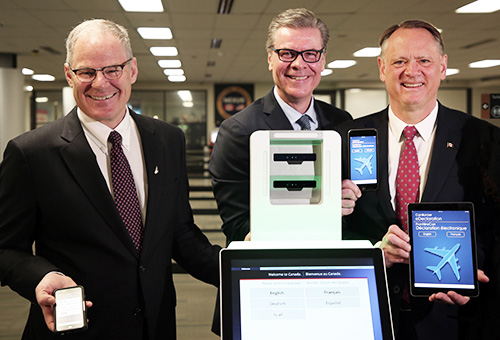
Mark Laroche, John Ossowski (President, Canada Border Services Agency) and The Honourable David McGuinty (MP, Ottawa South) launch PIK and the CanBorder app on March 17th.
On March 20, 2017, the Canada Border Services Agency activated the first Primary Inspection Kiosks (PIK) in Ottawa, along with CanBorder – eDeclaration, the Government of Canada’s mobile declaration application.
PIK allows international travellers arriving in Ottawa to verify their travel documents, complete an on-screen declaration, and confirm their identity using facial authentication which compares the photo taken at the kiosk with the user’s passport. The CanBorder app allows users to complete their declaration on their personal mobile device before arriving at the airport; the app generates a quick response (QR) code which is verified at the kiosk in the Customs Hall. The program has already grown to include the deployment of five additional kiosks for a total of 21.
Following the highly successful Ottawa launch, kiosks have been rolled out at five airports across the country, with more expected in 2018. The program will strengthen border security, simplify the border experience, and build upon the success experienced in other countries where automated border technology has already been implemented. Ottawa was proud to be the inaugural airport to offer this service in Canada.
Environmental Responsibility
Ensuring that it minimizes the impact its operations have on the environment continues to be a priority for the Authority. Two major programs in 2017 position us well for continued reduction in our overall footprint in the future.
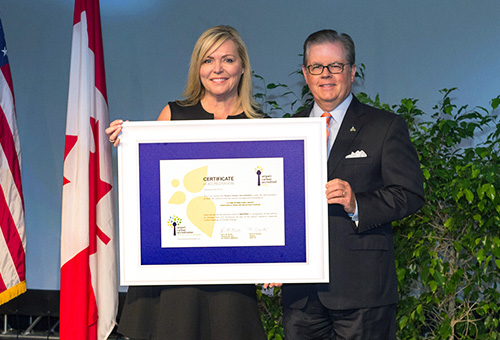
Krista Kealey, VP Communications & Public Affairs, accepts Level 1 of the Airport Carbon Accreditation Program on behalf of the Airport Authority.
Airport Carbon Accreditation Program
Late in 2016, the Authority was pleased to learn that it had completed the requirements to achieve Level 1 of Airports Council International-North America’s (ACI-NA) four-level Airport Carbon Accreditation Program. The process involved carbon footprint mapping for Authority-owned facilities and vehicles. Once completed, the calculations were verified by a third party in keeping with the program guidelines and submitted for review. The Authority received official recognition for this achievement at ACI-NA’s 2017 Annual General Meeting. Efforts in 2017 were focused on achieving Level 2 Accreditation for greenhouse gas emission reduction. This involved a study of our reduction opportunities and establishing reduction targets. We were successful in reaching this new milestone, with formal accreditation received on January 9th, 2018.
Parkade Lighting Upgrade
To reduce electricity consumption, which is a contributor of greenhouse gas, and improve the quality of the lighting in the Parkade, the Authority launched a project to replace the aging metal halide fixtures with a more energy-efficient solution. The Authority partnered with Energy Ottawa, Hydro Ottawa’s green power subsidiary, to test four different LED fixtures to determine the best solution for the environment.
The chosen solution, the IG Series LED Parking Garage fixture manufactured by Cree Inc. uses only 79 watts, with savings of 141 watts per fixture, to produce 7500 lumens of light. The fixture directs 6% of the light up to the ceiling, provides improved overall lighting uniformity, and comes with a 10-year fixture warranty. The fixtures have a programmable multi-level occupancy sensor with an ambient light sensor option that is programmed to dim the fixture down by 50% after 15 minutes of inactivity.
Macton Electric completed the 600-fixture installation which is expected to save an estimated 829,000 kWh, or $129,000 per year at today’s electricity rates. This project will also reduce our carbon footprint by 34 tonnes per year. The remaining 825 fluorescent fixtures that were installed as part of the 2010 Parkade expansion and, are already energy efficient, will be replaced as they reach end of life in several years.
Safety
The Authority continues to put the highest priority on safety at the Airport and invests much time and effort into ensuring that all activities at the Airport are carried out in the safest manner possible.
Safety Management System
The Authority has a comprehensive Safety Management System (SMS) program that outlines its commitment to excellence in safety management. The primary objective of the program is to build, operate and maintain a safe, sustainable Airport for our employees and customers.
From February 14th to 16th, Transport Canada (TC) was on-site to complete a full audit of all components of the program to verify that our Airport is in compliance and has the systems in place to ensure ongoing compliance with all regulatory requirements. On April 4th, we received the formal Surveillance Report from TC indicating that we are fully SMS-compliant.
Winter Operations
Snowfall in 2017 was greater than the previous winter with 258.4 cm overall which is higher than the 25-year average of 235 cm. To illustrate the conditions that were dealt with, 28 cm fell on February 12th, followed by another 23.8 cm on February 14th – dealing with nearly 52 cm in three days is a formidable challenge. However, our crews managed it with their usual professionalism, keeping the Airport open and operational throughout the storms.
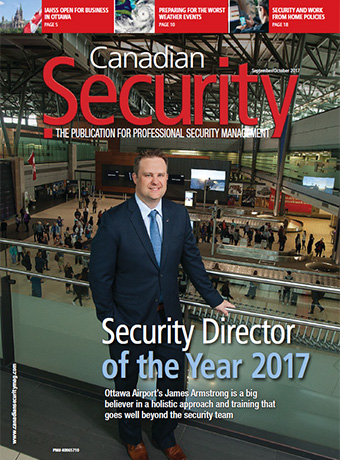
James Armstrong, VP Security, Emergency Management & Customer Transportation, was named Security Director of the Year 2017.
Security
The Authority has continued to explore new tools and programs to further enhance the airport’s security profile. The effort has been recognized, and in several cases, emulated by other organizations.
Security Director of the Year
James Armstrong, the Authority’s Vice President, Security, Emergency Management and Customer Transportation, was named Security Director of the Year by Canadian Security Magazine.
The awards program, whose candidates are senior security professionals across a variety of disciplines, is based on peer nominations that are evaluated and judged by a panel comprised of the magazine’s advisory board.
Annual Exercise
In anticipation of the many events planned to mark Canada’s 150th, the Authority’s annual emergency exercise was planned in conjunction with the City of Ottawa’s full-scale exercise, (C3). The event, which occurred on May 4th, included 20 hours of simulated incidents occurring at various venues across the city resulting from a region-wide earthquake. In the Airport Authority’s case, we were required to conduct an emergency response exercise, setting the stage for an earthquake aftershock scenario resulting in an airside ramp vehicle accident, fire and major fuel (HAZMAT) spill. The exercise expanded our test base to include our Environmental Services team and a few rarely tested stakeholders from the fuelling and ground handling service provider community.
Canine Awards

Russell Fox, Canine Handler, and Samson take silver in the detection category at the 2017 Canadian Police Canine Association National Detection Championship.
The Authority’s Canine Unit, which was created in 2011, is made up of three teams, each comprised of a handler and a dog. Handler Russ Fox and his dog Samson competed in the 2017 Canadian Police Canine Association National Detection Championships in Edmonton, Alberta. Competitors included more than 40 teams from various levels of government, law enforcement and conservation agencies from across the country, including the Ottawa Airport-based Canada Border Services Agency (CBSA) team of Todd Fulton and Peanut. Given that the two teams work and train together, it was fitting that they finished at the top together with CBSA taking the gold medal and the Authority taking silver.
YOW Security and Emergency Response Operational Enhancements
During the year, the Security and Emergency Management team initiated numerous operational improvements and efficiencies in their response capabilities. These included increased deterrence programs such as the introduction of an insider threat program and training; increased integration with the Ottawa Police Service, Ottawa Paramedic Service and Paladin Security for medical calls in the terminal; and an enhanced and more efficient airport aircraft emergency response capability that maximized existing response assets while reducing inefficiencies that prevented investment in other deterrence measures.
To reinforce the changes, and the Authority’s commitment to a safe and secure airport environment, the Authority hosted several training programs for its employees and campus partners. The training focused on several aspects of airport operations including counter insider threat, active shooter, Fire Warden, Airport Operations Coordination Centre, Ottawa Airport Emergency Response Service, and on-scene controller. Overall, Security and Emergency Management trained 516 airport staff members during 91 training events.
New Security Contractor
At the end of February, following a competitive tender process, the Authority announced that Paladin Security was selected as the new security contractor based on their modern and integrated approach to security. On March 1st, Paladin took over all patrol, traffic management, and security post identification verification and airside escort duties. The approximately 65 officers employed under the Paladin contract transitioned very seamlessly into their new role with no disruption or impact on customer service.
Finance
The Financial Year at a Glance
The Canadian economy experienced solid growth with key financial indicators and employment trends moving positively throughout the year, which was the backdrop for a positive impact on the 2017 results for the airport. 2017 passenger volumes again broke previous years’ records, surpassing 4.8 million passengers, an increase of 2.0% over 2016. While domestic passenger volumes grew in 2017 thanks to new destinations and increased frequencies, U.S. air carrier capacity continued to experience a decrease to U.S. hubs with many transborder passengers routed through Toronto and Montreal. Revenues in 2017 were 5.2% higher at $128.3 million, compared to $121.9 million in 2016, due to increases in non-aeronautical revenues resulting from enhanced ground transportation and parking initiatives, increased fees charged to airlines and higher passenger volumes which impacted concession revenues positively. As a result, the Authority finished 2017 by generating earnings before depreciation of $32.8 million compared to $22.8 million in 2016, and net earnings after depreciation of $3.8 million, compared to a net loss of $5.3 million in 2016. The Authority anticipated the year-over-year improvement in earnings due to the favorable interest impact from the Series D Bonds that matured and were repaid in May 2017. As always, any earnings continue to be reinvested in airport operations and development in the interest of improving safety, efficiency, and customer experience.
FIVE-YEAR REVIEW
| (in thousands of Canadian dollars) | 2013 $ |
2014 $ |
2015 $ |
2016 $ |
2017 $ |
|---|---|---|---|---|---|
| Revenues | 104,139 | 112,271 | 118,252 | 121,912 | 128,258 |
| Expenses before depreciation | 79,866 | 83,074 | 90,422 | 99,134 | 95,436 |
| Earnings before depreciation | 24,273 | 29,197 | 27,830 | 22,778 | 32,822 |
| Capital expenditures | 30,390 | 54,752 | 31,206 | 24,679 | 35,528 |
| AIF revenues | 38,370 | 43,629 | 45,434 | 46,920 | 49,110 |
To Pursue Excellence
Whether implementing new or enhanced customer service products and programs or ensuring that our employees are engaged, valued and recognized, the Authority recognizes that achieving excellence is a long-term commitment that we have always been ready to make.
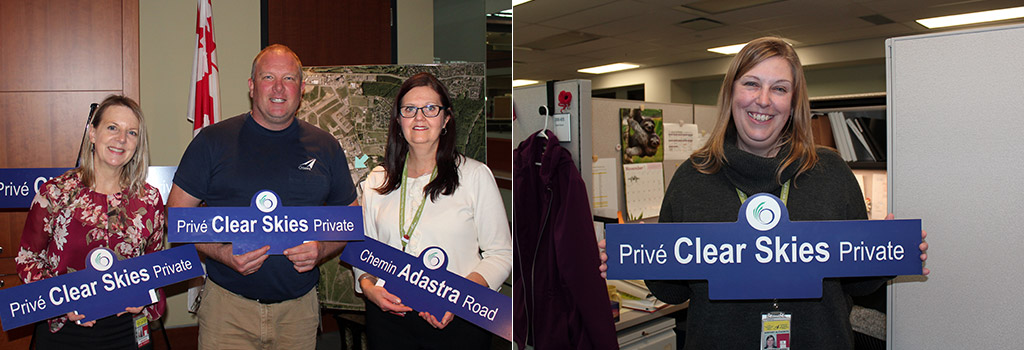
When the City of Ottawa looked to rename streets on Airport campus,, we asked employees to submit their suggestions. Winning choices included Clear Skies Private, put forward by Kristen Ewen (right), Lynn Lauriault and Marc Patry, and Adastra Road, proposed by Cathy McKechnie.
Customer Service
YOW is on the podium again in the 2017 Airport Service Quality (ASQ) Awards program. The Airport was ranked first in the category of Best Airport by Size and Region – North America for airports that serve between 2 and 5 million passengers per year, and tied for second place for Best Airport by Region – North America amongst all airports serving more than 2 million passengers.
ASQ is an Airports Council International (ACI)-led worldwide customer service benchmarking program that surveys departing passengers at the airport, and measures 34 key performance indicators. In 2017, there were 340 participating airports in 85 countries. Through the program, a prescribed number of passengers are surveyed quarterly ensuring an equitable breakdown between business and leisure travellers across domestic, transborder and international flights.
YOW also has the distinction of being an inductee to the ACI Director General’s Roll of Excellence which recognizes airports that have been ranked in the ASQ Survey for top five airports by size or region, and also by size and region for five of the 10 previous years.
Since joining the program in 2006, YOW has received a total of 22 awards for finishing top 3 in an award category:
| # of top 3 placements since 2006 |
North America | Size Category | Size and Region | Total |
|---|---|---|---|---|
| 11 | 10 | 1 | 22 |

Lise Clément and Suzanne Orlik are two of 80 Infoguide volunteers who contributed 7,328 customer service hours in 2017. During a summer appreciation event, they enjoyed visiting some of the Canada 150 attractions in Ottawa-Gatineau, such as MosaïCanada 150 in Jacques-Cartier Park.
2017 was a very special year for our city and for the Airport as we celebrated Canada’s 150th birthday. As the gateway into Canada’s Capital Region, we welcomed visitors as they arrived for national and local celebrations. Earning gold and silver medals based on feedback from our clients makes these awards even more significant. They are a wonderful testament to the hard work and dedication of every airport employee who made the welcome so special, and we share these awards with the entire community, including airlines, ground handlers, cleaning staff, customs agents, retailers, restaurateurs, volunteers and everyone in-between.
We also extend heartfelt thanks to every passenger who took the time to complete a survey as they awaited their departing flight from YOW.
Overall, YOW scored 4.47 out of 5 points, which represents a slight increase from 2016. Notable improvements include:
- Value for money of parking facilities (4.9%)
- Shopping facilities (4.6%)
- Restaurant/eating facilities (3.0%)
As always, we will be reaching out to the airport campus partners that contribute to the customer experience in the near future to share the details of the year-end summary. Together, we can continue to effect positive change in the areas where additional attention will make a difference, as well as learning what activities helped make a difference in the eyes of our customers in 2017.
Congratulations to all and keep up the great work!
Employee Engagement
Employees have always been vital to the Authority’s success, and ensuring that they are engaged remains an organizational priority. As such, every opportunity to celebrate, recognize and communicate with the entire team was seized.
New communications tools, including an employee blog and operational update reports from the CEO, were developed and deployed. The Authority, through its partnership with Ottawa 2017, ensured that employees were given the opportunity to attend and participate in unique events that marked Canada’s 150th, such as the Sky Lounge, Canada’s Table and more. Also, long service awards celebrated the 5, 10, and 20-year milestones that many of our employees reached during the year.
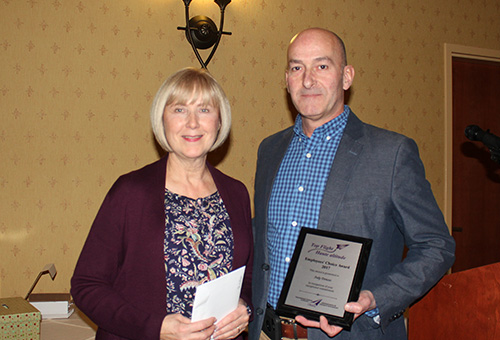
Judy Donoso, Administrative Assistant, Airside Operations, received the Employee’s Choice Award on December 15th from Mark Faubert, Director of Human Resources.
Top Flight
The Authority’s Human Resources team launched Top Flight in 2013 to provide its employees with a means for recognizing their colleagues for going above and beyond the call of duty. Nominees are recognized quarterly, and at year end, all Authority employees are asked to vote on the nomination they feel is most worthy of the Employee’s Choice Award.
We are pleased to announce that Judy Donoso was selected as the 2017 Employee’s Choice Award recipient. Judy, who works at the Hendrick Building and provides invaluable assistance to the airfield team, was nominated in the Commitment category for assisting a very large team, including all seasonal staff, and always handling everything she does for them and others with professionalism and a smile.
To provide additional flight frequencies and destinations
Air Service Development
Porter Airlines announced three new routes in 2017. Service to Fredericton was added on September 12th, and service to Saint John, New Brunswick, started shortly after on September 21st. In late September, Porter announced that seasonal service to Orlando-Melbourne Airport, its first U.S. destination from Ottawa, would run on Saturdays from December 16th, 2017, to March 31st, 2018. Service to this airport, located on Florida’s east coast, gives passengers another option when choosing to fly to the Orlando area. Porter also offered a special holiday schedule from Ottawa to Stephenville, Newfoundland, on Wednesdays, from December 20th, 2017, to January 3rd, 2018.

Porter Airlines’ inaugural flight from Saint John, New Brunswick was welcomed with a water salute on September 21st.
Although Porter is the only airline that added multiple destinations this year, other carriers also saw growth:
- Delta Air Lines added a daily flight to New York’s LaGuardia Airport.
- WestJet added eight weekly flights between Ottawa and Toronto. Their seasonal service between Ottawa and Edmonton will now operate year-round.
- In 2017, American Airlines announced that it will be adding an additional frequency between Philadelphia International Airport and Ottawa starting May 4th, 2018. This route will now be operated three times daily, year-round.
- The charter season, which runs between November 2017 and the end of April 2018, will include over 60 weekly flights to sun destinations in Florida, Mexico, and the Caribbean. Air Canada, Air Transat, Celebrity Cruises, Porter Airlines, Sunwing, and WestJet will provide passengers with numerous options to escape the cold.
Total
nonstop
destinations
| TOTAL | |
|---|---|
| 1997 | 20 |
| 1998 | 21 |
| 1999 | 25 |
| 2000 | 26 |
| 2001 | 29 |
| 2002 | 30 |
| 2003 | 32 |
| 2004 | 25 |
| 2005 | 39 |
| 2006 | 44 |
| 2007 | 49 |
| 2008 | 49 |
| 2009 | 49 |
| 2010 | 50 |
| 2011 | 49 |
| 2012 | 49 |
| 2013 | 49 |
| 2014 | 50 |
| 2015 | 49 |
| 2016 | 46 |
| 2017 | 46 |
Commercial
aircraft
movements
| TOTAL | |
|---|---|
| 1997 | 68,000 |
| 1998 | 77,202 |
| 1999 | 81,808 |
| 2000 | 78,301 |
| 2001 | 72,630 |
| 2002 | 68,499 |
| 2003 | 69,798 |
| 2004 | 69,626 |
| 2005 | 66,146 |
| 2006 | 65,396 |
| 2007 | 72,342 |
| 2008 | 79,777 |
| 2009 | 81,120 |
| 2010 | 86,009 |
| 2011 | 90,949 |
| 2012 | 90,697 |
| 2013 | 83,567 |
| 2014 | 78,073 |
| 2015 | 75,107 |
| 2016 | 74,345 |
| 2017 | 74,755 |
Daily
nonstop
flights
| DOMESTIC | TRANSBORDER | INTERNATIONAL (WEEKLY) | |
|---|---|---|---|
| 1997 | 82 | 21 | 3 |
| 1998 | 88 | 23 | 6 |
| 1999 | 101 | 39 | 7 |
| 2000 | 93 | 43 | 7 |
| 2001 | 84 | 30 | 7 |
| 2002 | 80 | 35 | 8 |
| 2003 | 81 | 35 | 7 |
| 2004 | 71 | 35 | 7 |
| 2005 | 60 | 32 | 9 |
| 2006 | 60 | 29 | 9 |
| 2007 | 70 | 31 | 11 |
| 2008 | 77 | 32 | 13 |
| 2009 | 80 | 29 | 14 |
| 2010 | 86 | 30 | 17 |
| 2011 | 93 | 30 | 22 |
| 2012 | 91 | 31 | 25 |
| 2013 | 84 | 27 | 22 |
| 2014 | 80 | 24 | 23 |
| 2015 | 78 | 21 | 24 |
| 2016 | 80 | 20 | 23 |
| 2017 | 82 | 19 | 23 |
Origin and destination
96.0% of traffic (estimated)
STRATEGIC INITIATIVES
The Authority’s Strategic Plan was collaboratively developed with the Board of Directors and Senior Management Team, and is based on five key Strategic Directions that are still the focus of Airport Authority activity. The following identifies the initiatives within each Direction across the 2017-2021 timeline:
- To grow strategically
- to grow non-aeronautical revenues; and
- to provide passengers and commercial airlines with world class airport facilities.
- To increase the economic footprint of the airport within Canada’s Capital Region
- to increase the economic impact of the airport by generating employment and economic activity on airport land; and
- to ensure efficient transportation access to the airport through continued advocacy with the City of Ottawa concerning a Light Rail Transit (LRT) airport link.
- To optimize operational performance, ensuring safe and secure operations
- to be recognized for strong financial management practices and strong financial performance among airports in Canada;
- to show continued leadership in airport safety and security; and
- to show continued leadership in sustainable airport management and environmental practice.
- To pursue excellence
- to continue to achieve consistently high customer satisfaction;
- to ensure excellence in employee engagement; and
- to demonstrate leadership in corporate governance.
- To provide additional flight frequencies and destinations
- to increase flight options through the implementation of an effective air service development strategy; and
- to support tourism, business and convention development in Ottawa by stimulating demand for air travel.
2017 Actual vs. Business Plan
| (in millions of Canadian dollars) | ACTUAL $ |
PLAN $ |
VARIANCE $ |
|
|---|---|---|---|---|
| Revenues | 128.3 | 126.5 | 1.8 | Increase in passenger and origin and destination volumes combined with an increase in car rental and ground transportation volumes and revenues. |
| Expenses | 124.4 | 128.0 | (3.5) | Lower than expected operational and repair and maintenance services combined with lower contract services expenses. |
| Capital expenditures | 35.5 | 38.4 | (2.9) | Initiatives related to fleet vehicles, boarding bridge refurbishment and campus and building finishes and upgrades had longer than expected lead times together with some elements of the project slipping into the next fiscal year. |
Financial projections 2018 – 2022
| (in millions of Canadian dollars) | 2018 $ |
2019 $ |
2020 $ |
2021 $ |
2022 $ |
|---|---|---|---|---|---|
| Revenues | 131.7 | 135.2 | 138.8 | 142.6 | 146.4 |
| Expenses | 127.7 | 130.1 | 132.9 | 134.6 | 136.6 |
| Capital expenditures | 48.9 | 35.1 | 30.3 | 24.6 | 25.8 |



